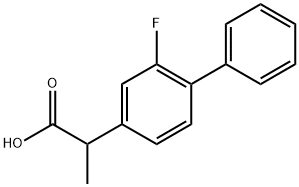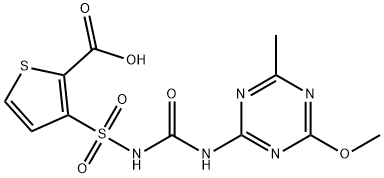Suprofen
Synonym(s):α-Methyl-p-(2-thenoyl)phenylacetic acid;(±)-Suprofen;2-[4-(Thiophene-2-carbonyl)phenyl]propanoic acid;NSC 303611;p-(2-Thenoyl)hydratropic acid
- CAS NO.:40828-46-4
- Empirical Formula: C14H12O3S
- Molecular Weight: 260.31
- MDL number: MFCD00079572
- EINECS: 255-096-9
- SAFETY DATA SHEET (SDS)
- Update Date: 2024-11-20 15:18:15

What is Suprofen?
Toxicity
Symptoms of overdose include bleeding in the eye or redness or swelling of the eye or the eyelid, blurred vision or other change in vision, fever or chills, itching or tearing, nausea or vomiting, pain, sensitivity to light, shortness of breath, sticky or matted eyelashes, swelling of face, throbbing pain, tightness in chest, troubled breathing, and wheezing.
Description
Suprofen is an arylpropionic acid analgesic/antiinflammatory agent with close structural resemblance to ketoprofen. It is more potent in many assays than indomethacin and ketoprofen and appears better tolerated.
Chemical properties
Off-White to Light-Brown
Originator
Janssen (Belgium)
The Uses of Suprofen
Prostaglandin biosynthesis inhibitor. Analgesic
The Uses of Suprofen
Bridged pseudopelletierine derivative; specific serotonin (5HT3) receptor antagonist. Antiemetic.
Background
An ibuprofen-type anti-inflammatory analgesic and antipyretic. It inhibits prostaglandin synthesis and has been proposed as an anti-arthritic. It is no longer approved for use in the United States.
Indications
Used as eye drops to inhibit the miosis (pupil constriction) that may occur during ocular surgery.
What are the applications of Application
Suprofen is a prostaglandin biosynthesis inhibitor
Definition
ChEBI: An aromatic ketone that is thiophene substituted at C-2 by a 4-(1-carboxyethyl)benzoyl group.
brand name
Profenal (Alcon);Algiamida;Algiasdi;Bordol;Erdol;Masterfen;Sufenid;Supranol;Surfex;MALDOCIL.
Pharmacokinetics
Suprofen is a non-steroidal anti-inflammatory analgesic and antipyretic. Ophthalmic anti-inflammatory medicines are used in the eye to lessen problems that can occur during or after some kinds of eye surgery. Sometimes, the pupil of the eye gets smaller during an operation (pupil constriction), making it more difficult for the surgeon to reach some areas of the eye. Suprofen is used to help prevent this.
Veterinary Drugs and Treatments
Suprofen is a non-steroidal anti-inflammatory agent similar to flurbiprofen. Suprofen and flurbiprofen are phenylalkanoic acids that inhibit the cyclo-oxygenase enzymes responsible for conversion of arachadonic acid from cell membranes into various prostaglandins. These prostaglandins mediate certain aspects of ocular inflammation including disruption of the blood-aqueous barrier, uveal vasodilation, increases in intraocular pressure, and leakage of white blood cells and protein from uveal vessels into the aqueous humor. Prostaglandins cause iris sphincter constriction (miosis) independent of cholinergic mechanisms. Suprofen can inhibit this intraocular miosis and may also be useful in the management of uveal inflammation (usually in addition to topical steroids).
Metabolism
Primarily hepatic (mainly via cytochrome P450 isozyme 2C9).
Properties of Suprofen
| Melting point: | 278°C |
| Boiling point: | 373.57°C (rough estimate) |
| Density | 1.2959 (rough estimate) |
| refractive index | 1.5050 (estimate) |
| storage temp. | Keep in dark place,Sealed in dry,Store in freezer, under -20°C |
| solubility | DMF: 30 mg/ml; DMSO: 30 mg/ml; Ethanol: 20 mg/ml; PBS (pH 7.2): 0.5 mg/ml |
| pka | 3.91(at 25℃) |
| form | Powder |
| color | White to off-white |
| Water Solubility | soluble |
| CAS DataBase Reference | 40828-46-4(CAS DataBase Reference) |
Safety information for Suprofen
| Signal word | Danger |
| Pictogram(s) |
 Skull and Crossbones Acute Toxicity GHS06 |
| GHS Hazard Statements |
H301:Acute toxicity,oral |
Computed Descriptors for Suprofen
New Products
Tert-butyl bis(2-chloroethyl)carbamate 4-Methylphenylacetic acid N-Boc-D-alaninol N-BOC-D/L-ALANINOL N-octanoyl benzotriazole 3-Morpholino-1-(4-nitrophenyl)-5,6-dihydropyridin- 2(1H)-one Furan-2,5-Dicarboxylic Acid DIETHYL AMINOMALONATE HYDROCHLORIDE 1,1’-CARBONYLDIIMIDAZOLE R-2-BENZYLOXY PROPIONIC ACID 1,1’-CARBONYLDI (1,2-4 TRIAZOLE) N-METHYL INDAZOLE-3-CARBOXYLIC ACID (2-Hydroxyphenyl)acetonitrile 4-Bromopyrazole 5-BROMO-2CYANO PYRIDINE 5,6-Dimethoxyindanone 5-broMo-2-chloro-N-cyclopentylpyriMidin-4-aMine 2-(Cyanocyclohexyl)acetic acid 4-methoxy-3,5-dinitropyridine 1-(4-(aminomethyl)benzyl)urea hydrochloride 2-aminopropyl benzoate hydrochloride diethyl 2-(2-((tertbutoxycarbonyl)amino) ethyl)malonate tert-butyl 4- (ureidomethyl)benzylcarbamate Ethyl-2-chloro((4-methoxyphenyl)hydrazono)acetateRelated products of tetrahydrofuran








You may like
-
 Suprofen 98% (HPLC) CAS 40828-46-4View Details
Suprofen 98% (HPLC) CAS 40828-46-4View Details
40828-46-4 -
 Suprofen CAS 40828-46-4View Details
Suprofen CAS 40828-46-4View Details
40828-46-4 -
 1975-50-4 98%View Details
1975-50-4 98%View Details
1975-50-4 -
 2-HYDROXY BENZYL ALCOHOL 98%View Details
2-HYDROXY BENZYL ALCOHOL 98%View Details
90-01-7 -
 2-Chloro-1,3-Bis(Dimethylamino)Trimethinium Hexafluorophosphate 221615-75-4 98%View Details
2-Chloro-1,3-Bis(Dimethylamino)Trimethinium Hexafluorophosphate 221615-75-4 98%View Details
221615-75-4 -
 14714-50-2 (2-Hydroxyphenyl)acetonitrile 98+View Details
14714-50-2 (2-Hydroxyphenyl)acetonitrile 98+View Details
14714-50-2 -
 118753-70-1 98+View Details
118753-70-1 98+View Details
118753-70-1 -
 733039-20-8 5-broMo-2-chloro-N-cyclopentylpyriMidin-4-aMine 98+View Details
733039-20-8 5-broMo-2-chloro-N-cyclopentylpyriMidin-4-aMine 98+View Details
733039-20-8